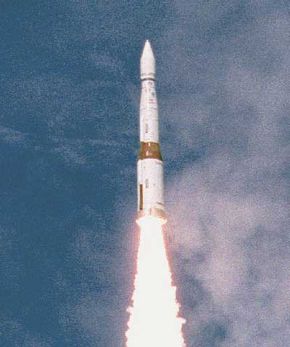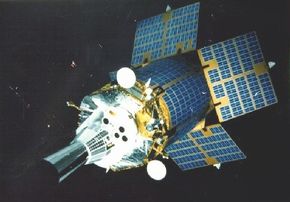The idea of a missile-defense shield received a lot of attention about two decades ago, when then-President Ronald Reagan proposed his Strategic Defense Initiative (SDI). SDI called for the deployment of space-based weapons that would shoot down intercontinental ballistic missiles (ICBMs). Its proposed use of lasers and spacecraft led the media and critics to dub the system "Star Wars." While Reagan's ambitious defense plan focused the world's attention on missile-defense systems, the origins of such a system dates back to the beginning of the Cold War.
In 1946, following the discovery of a Nazi missile program, which included plans to launch ICBMs at New York City, the U.S. Army began to study interceptor missiles that could destroy incoming ballistic missiles. In 1961, the Army achieved the first successful intercept of a dummy ICBM warhead, which led to a major push for the deployment of a national defense shield. Six years later, the nation's first missile-defense program, called Sentinel, was deployed.
In 1968, President Richard Nixon refocused the Sentinel system to protect U.S. deterrent forces. The system was renamed Safeguard. Safeguard interceptors were designed to carry warheads to destroy re-entry vehicles of ICBMs.
Negotiations between the United States and the Soviet Union over the proliferation of arms yielded the Anti-ballistic Missile Treaty (ABM) of 1972. The ABM treaty banned national missile-defense systems and was intended to prevent the further escalation of the arms race between the two countries. Under this treaty, the U.S. and the Soviet Union agreed to limit missile-defense systems to two sites per country, with no site having more than 100 interceptors. The number of sites was reduced to one in 1974. The United States placed its site in Grand Forks, N.D., but closed it in 1976.
The ABM treaty must be altered or rejected by the U.S. if it is to deploy a national missile shield. During the 2000 presidential campaign, President Bush said that he would pursue a national missile-defense system, even at the expense of damaging foreign relations with Russia. He said that he would work to amend the ABM treaty, but that he would push for an American withdrawal from the treaty if he had to. Defense secretary Rumsfeld has said that the ABM treaty is outdated because many other nations have developed long-range missile technology in the 30 years since it was signed.
Through the late 1970s and early 1980s, the military turned its attention to developing a missile-defense system that did not rely on warhead-equipped interceptors. To this end, the U.S. Army developed a sensor and guidance system that enabled an interceptor to collide with an enemy warhead. This technology was demonstrated in 1984. (A year earlier, President Reagan had announced his Strategic Defense Initiative (SDI) in a televised national address).
Following the end of the Cold War, some suggested that Reagan's SDI plans were no longer necessary. In 1991, President George Bush called for a revised missile-defense system that would use ground-based rocket interceptors. In that same year, the world saw the first engagement of a ballistic missile and a missile defense system during the Persian Gulf War, when an American Patriot missile destroyed an Iraqi Scud missile. Bush's plans laid the groundwork for the system now being backed by his son, George W. Bush.
In 1998, a congressional commission released the Rumsfeld Report, which stated that several countries would have the ability to strike the U.S. mainland within five to 10 years. Six weeks after the report was released, North Korea tested a three-stage missile that passed over Japan. North Korean testing led the U.S. Congress to pass the National Missile Defense Act of 1999, which committed the United States to establishing a missile-defense shield. NMD is projected to be operational by 2005.

